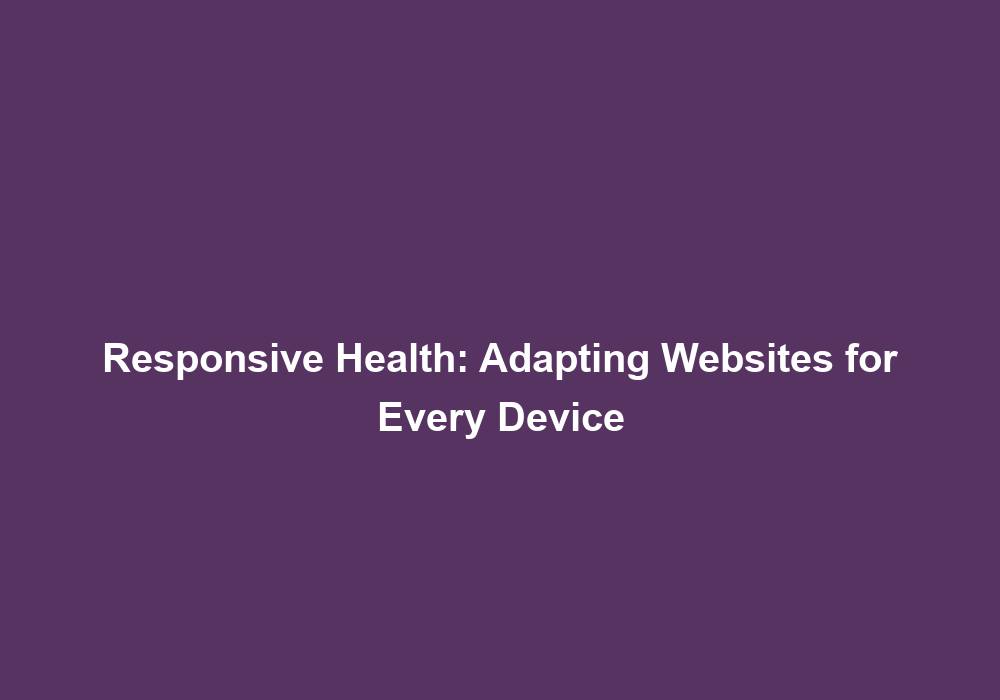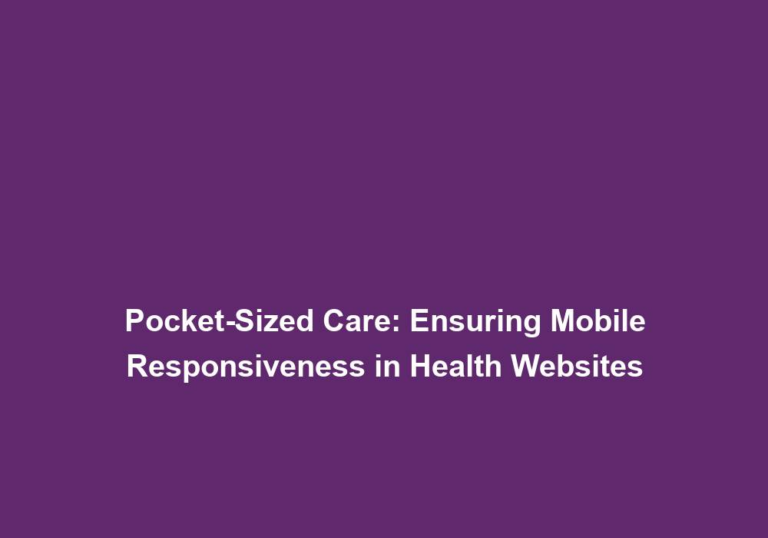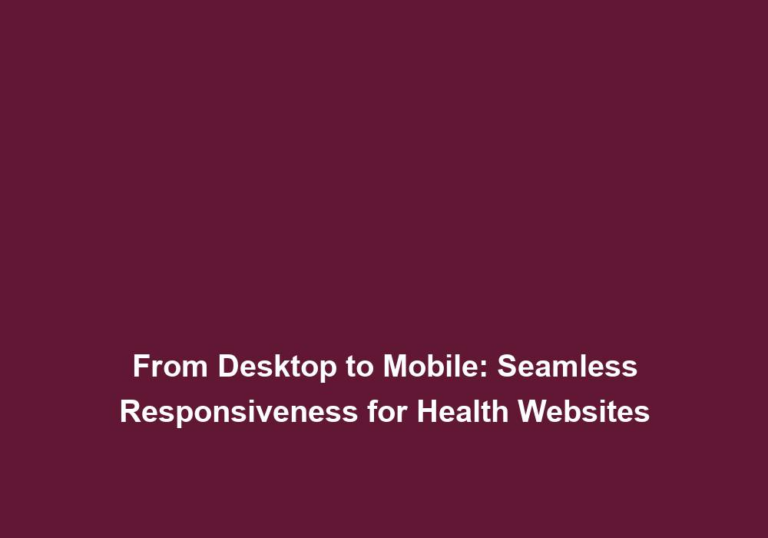Responsive Health: Adapting Websites for Every Device
In today’s digital age, having a responsive website is no longer an option but a necessity, especially in the healthcare industry. With the increasing use of smartphones, tablets, and other mobile devices, it is crucial for healthcare websites to adapt and provide a seamless user experience across all devices. This article will delve into the importance of responsive health websites and provide valuable insights on how to optimize your healthcare website for every device.
Why Responsive Health Websites Matter
- Improved User Experience:
- A responsive website ensures that your healthcare content is easily accessible and readable on any device, regardless of the screen size or resolution. This enhances the overall user experience, leading to increased engagement and higher patient satisfaction.
- Responsive design elements, such as flexible images and fluid grids, allow for easy navigation and intuitive interaction, enabling users to find the information they need quickly and efficiently.
- Additionally, responsive websites adapt to different orientations, whether the device is held vertically or horizontally, providing a seamless experience in any position.
- Enhanced SEO Performance:
- Search engines prioritize responsive websites in their algorithms, as they provide a superior user experience. Having a responsive health website can positively impact your search engine rankings, leading to increased organic traffic and visibility.
- With a responsive design, you can consolidate your SEO efforts into a single website, avoiding the need for separate mobile and desktop versions. This streamlines your SEO strategy and improves your website’s overall performance.
- Furthermore, a responsive website reduces the chances of duplicate content, as all visitors are directed to the same URL regardless of the device they use. This helps to avoid any negative impact on your search engine rankings.
- Increased Mobile Usage:
- Mobile devices have become an integral part of our daily lives, and this trend extends to healthcare. More and more patients are using their smartphones and tablets to search for healthcare providers, book appointments, and access medical information.
- By ensuring your healthcare website is responsive, you can tap into this growing mobile audience and reach potential patients wherever they are. A mobile-friendly website demonstrates your commitment to providing accessible healthcare services to all users.
- Moreover, a responsive health website allows for easy integration with mobile-specific features such as GPS location services, click-to-call functionality, and appointment booking applications. This further enhances the user experience and convenience for mobile users.
Key Elements of Responsive Health Websites
- Fluid Grid System:
- Implementing a fluid grid system ensures that your healthcare website adapts to different screen sizes. This grid adjusts the layout and proportions of your website’s elements, allowing for a seamless user experience across devices.
- Use relative units like percentages instead of fixed pixels to ensure that your website’s design elements scale proportionally on different devices.
- Additionally, consider employing media queries to apply specific styles or adjust the layout based on the screen size, providing an optimized experience for each device.
- Flexible Images and Media:
- Images play a vital role in healthcare websites, from showcasing facilities and services to featuring medical professionals. To ensure a responsive design, use CSS techniques such as max-width: 100% to make images adjust to the width of the screen without distorting or overflowing.
- Similarly, videos and other media should be embedded using responsive techniques, ensuring they resize and reposition appropriately on different devices.
- Optimize image file sizes for faster loading times without compromising quality, as this contributes to a positive user experience and improved SEO performance.
- Clear and Concise Content:
- When optimizing your healthcare website for responsive design, it is essential to ensure that your content remains clear and concise across devices. Long paragraphs or complicated layouts can be overwhelming on smaller screens.
- Break down your content into easily scannable sections and use headings, subheadings, and bullet points to improve readability. This way, users can quickly find the information they are looking for, even on smaller devices.
- Additionally, consider using expandable content sections or accordions to provide a streamlined user experience, allowing users to access additional information without cluttering the initial view.
- Optimized Navigation:
- Navigation is a critical aspect of any website, and it becomes even more crucial in responsive health websites. Ensure that your navigation menu is easily accessible and functional on all devices.
- Consider using a collapsible or hamburger menu for smaller screens to save space while maintaining usability. It is also essential to prioritize the most important sections or pages in your navigation to optimize the user experience.
- Implement breadcrumb navigation to provide users with clear paths and easy access to different sections of your healthcare website, enhancing overall navigation and user satisfaction.
- User-Friendly Forms:
- Forms are commonly used on healthcare websites for appointment bookings, contact forms, or patient registration. When designing forms for a responsive website, keep in mind the limited screen size of mobile devices.
- Use input fields that are easy to tap, provide clear instructions, and include validation messages to ensure a smooth user experience. Test the forms across different devices to ensure they work seamlessly for all users.
- Additionally, consider implementing autofill features, pre-populated dropdown menus, and input field validation in real-time to minimize user effort and errors when completing forms.
Best Practices for Responsive Health Websites
- Mobile-First Approach:
- When designing or revamping your healthcare website, prioritize the mobile experience. Start by creating a mobile-friendly layout and gradually enhance it for larger screens.
- This approach ensures that your website’s core functionality and content are optimized for mobile users, who represent a significant portion of your audience.
- Conduct user testing on different mobile devices to identify any usability issues and make necessary adjustments to provide a seamless mobile experience.
- Regular Testing and Optimization:
- Continuously test your responsive health website across various devices, browsers, and screen sizes. This will help you identify any design or functionality issues and make necessary optimizations.
- Regularly review your website’s analytics to gain insights into user behavior and make data-driven improvements. Analyze user flow, bounce rates, and conversion rates to identify areas for enhancement.
- Implement A/B testing to compare different versions of your website and determine which elements or layouts result in better user engagement and conversions.
- Maintain Consistent Branding and Messaging:
- Regardless of the device, it is crucial to maintain consistent branding and messaging across your healthcare website. This includes using the same colors, fonts, and imagery to reinforce your brand identity.
- Consistency in branding and messaging helps build trust and recognition among users, regardless of the device they are accessing your website from.
- Consider creating style guides or brand guidelines to ensure that all elements of your responsive health website align with your brand’s visual identity and tone.
- Speed Optimization:
- Page loading speed is critical for user experience and SEO. Optimize your responsive health website for fast page loading times by compressing images, minifying code, and leveraging caching techniques.
- Mobile users, in particular, expect quick and seamless browsing experiences. By prioritizing speed, you can reduce bounce rates and improve overall user satisfaction.
- Regularly monitor and optimize server performance to ensure fast response times, as slow servers can significantly impact the user experience on mobile devices.
In conclusion, having a responsive health website is essential for delivering a seamless user experience and optimizing your online presence. By implementing responsive design principles, optimizing content, and following best practices, you can ensure that your healthcare website adapts effortlessly to every device. Embrace the power of responsive health websites to enhance patient engagement, boost search engine rankings, and drive overall success in the digital realm.







